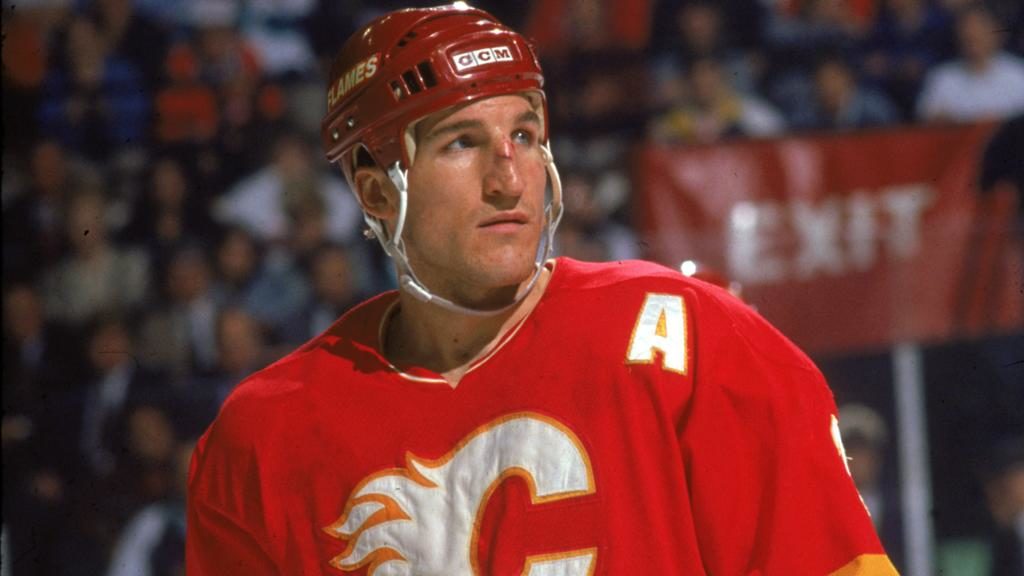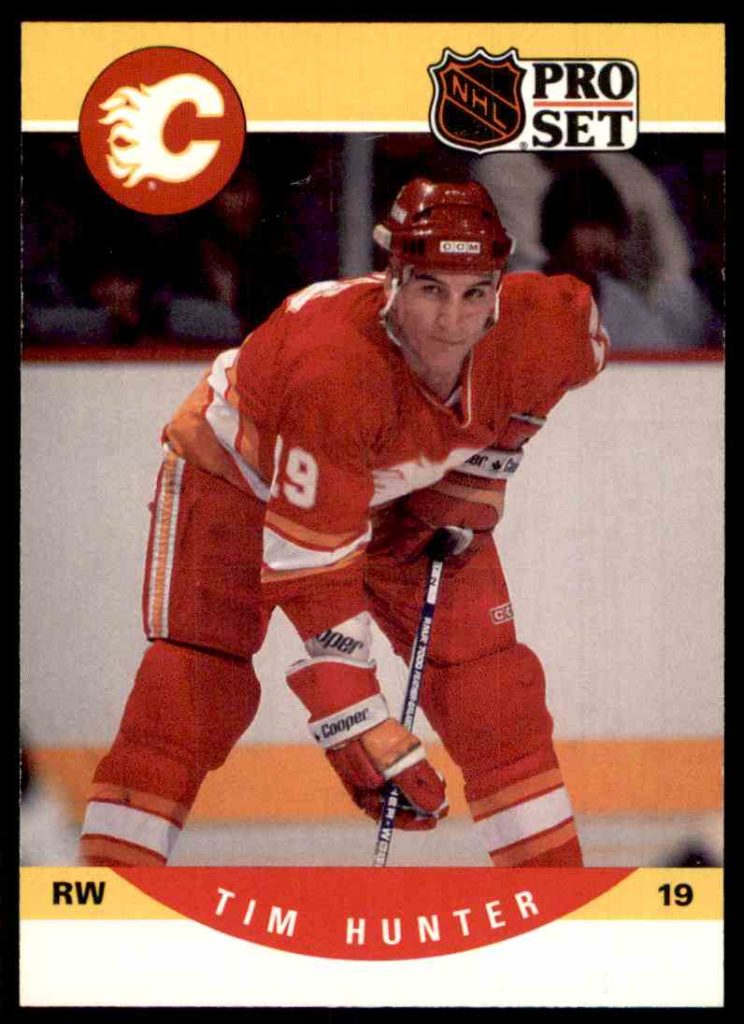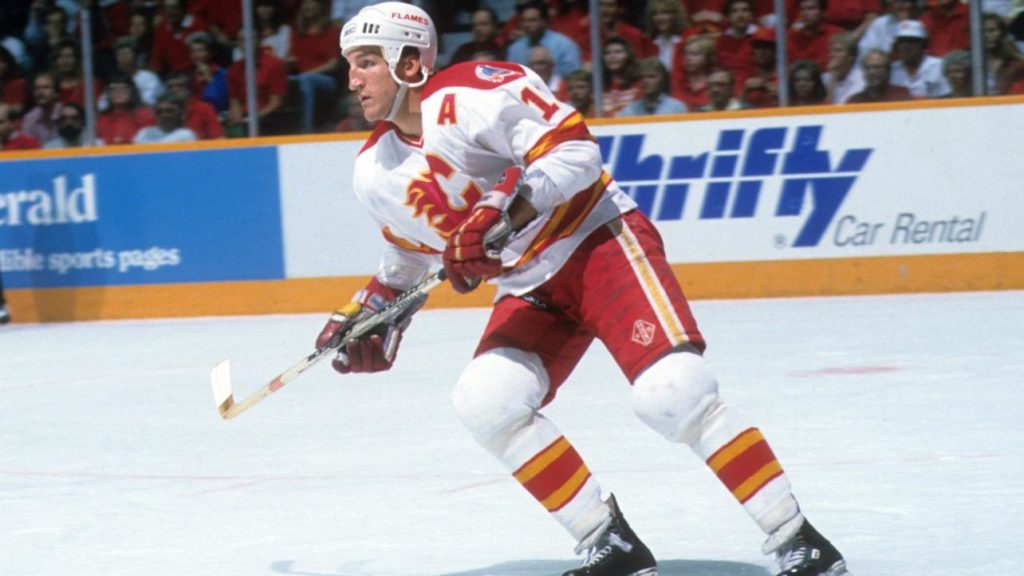
Innovating Hockey Fight Tactics: Tim Hunter and the Crossover-grip.
When I look back on Tim Hunter’s career as an enforcer one of the first things I think of is the way he innovated hockey fighting tactics. He did this by employing what has become known as the crossover-grip or cross-grip. Whichever name you choose to call it, this simple little maneuver would go on to have a huge influence on the way players fought and developed their fighting styles from the early-mid 80’s and throughout the ‘90’s. Before long numerous players would be using this same little maneuver. Some would use it as one part of their overall style; others would use it as their defining technique.
Now in a conventional fight between two right handers, the idea is to use your left to first anchor yourself but also to tie up your opponent’s right arm. So you grab onto your opponents right arm or even right shoulder with your left to tie him up and keep him from punching. What Hunter did was start off like he was going to fight in an orthodox stance but then he’d crossover – by reaching over with his right hand and tying up his opponents right. This would usually leave his left free for him to go on the offensive. Many times this simple little maneuver would catch guys unawares and, if you happened to be one of them one hand dominant style fighters, it could spell trouble.

If you go back and follow Tim Hunter on video tape you can almost pinpoint its first use and how simple and brilliant a tactic it could be. Tim Hunter’s first NHL fight was against Glen Cochrane. This was in 81-82 and Hunter went mostly with a conventional, orthodox style, firing all rights before falling to end the fight. The next fight you’ll find on video is the following year against Nick Fotiu. Fotiu didn’t fight much but when he did he could be trouble. He made short work of Hunter firing off a quick flurry and overwhelming the young Calgary tough guy. Hunter really didn’t have time to do much of anything in that one.
Then came the Semenko fight. This was their memorable fight from the ’83 playoffs. They had fought earlier in the year but there is no video available on that one and details are sketchy. But their fight in the opening round of the ’83 Stanley Cup playoffs was the moment the world was introduced to the vaunted crossover-grip. In that fight Semenko was in control of the early going. You can actually see Hunter try and crossover and tie up Semenko’s right but he fails and uncharacteristically loses his grip altogether. Semenko took control and began landing some shots and had the early advantage. Then Hunter was able to switch his grip. He was able to use his right to tie up Sammy’s right. Once he was able to do that, he could fire away with his left. Semenko had no idea what kind of black magic Hunter was using. He was crossed up and being mostly a right hander, almost paralyzed. Hunter was at first firing away and coming up short but he slowly but surely found the range with his lefts. Semenko would attempt to meekly paw with his right but Hunter had him locked down and pounded away until the linesmen jumped in. Hunter had slayed the beast.
Now Semenko’s sucker punch after the fact, with the linesmen attempting to separate the two combatants, overshadowed what was a work of hockey fighting art. The most fearsome enforcer in the game had been rendered almost helpless. Calgary now had someone who could at least contain Semenko as the Battle of Alberta in the ‘80’s continued to heat up.

Hunter was not an overly big guy. He was about 6’2, 200 lbs. He was wiry but strong with a long broken beak that looked like it was used to taking all kinds of punishment. With guys like Dave Semenko, Larry Playfair, Behn Wilson, Nick Fotiu, Glen Cochrane, Clark Gillies, etc running around, Hunter had to use brains as well as brawn to hold his own in this league. So Hunter became a well-conditioned fighter who could not only go toe to toe but also push the fight into the later rounds and go the long haul. In a league of big men and big punchers, Hunter was more of a technical sort with a style all his own. He could tie you up, wear you down and go on the attack when the moment was right.
Hunter would use the crossover-grip as the main feature of his overall technique. It was perfect for shutting down any of those one armed bandits out there. It was also an excellent way to get a quick advantage in a fight by crossing up an opponent. Even if the opponent could switch hands, and the advantage only slight, it might still mean the difference between victory and defeat.
Now let’s fast forward a bit through Hunter’s career in footage and highlight a few fights. The following season (83-84) he used the crossover-grip in his great fight with Edmonton’s Don Jackson. In that fight you can see Jackson attempt to punch through Hunter’s grip but it wasn’t enough and most of his punches fell short.
Then fast forward to the 84-85 season. Hunter used the crossover-grip against Don Jackson again, this time dropping Jackson. He slugged it out with Jackson with rights but once he switched to the crossover-grip, Jackson had no chance.
He then used it in that wild fight against Kevin McClelland. Now I don’t know if anyone noticed this but Hunter actually had the crossover-grip on K-Mac’s left while they were both punching from the ice.
Hunter would then use it masterfully once again on Dave Semenko later in the year, once again shutting the Oiler policeman down. This time there was no cheap sucker punch to mar a great victory for Hunter. So you can see that this simple little maneuver was a big factor in some of his biggest fights-and this is just a few years into his career.
Before Hunter came along, I never really saw anyone use this as a legitimate tactic in a fight. On the rare occasion when I’d see a fighter use this-usually a lefty- it almost seemed accidental, something that just happened by chance during the fight. I certainly never saw it used as part of a fighters overall strategy bout after bout. For Hunter it became his go to tactic. Before long, other fighters would also be using the crossover-grip as well, spurred on, no doubt, by Hunter’s success with it. Guys like John Kordic, Basil McRae, Ken Baumgartner, Kelly Chase, Alan May, Jacques Mailhot, Phil Crowe, Jim McKenzie and Stu Grimson are some of the more well-known practitioners of the vaunted crossover-grip.
One of the more inherent weaknesses of the crossover-grip is that it is less effective against fighters who could switch hands. It’s a beautiful tool when you’re taking on a guy who can only throw from one side but as time went by more and more fighters, Heavyweights included, came into the league throwing from both sides. So it went from being a defense to offense set up maneuver to becoming a purely offensive one. You’d even have occasions where you would have two fighters using the crossover-grip, not as a way to tie up there opponent but because some preferred the angles it created. I remember seeing Phil Crowe fight Jacques Mailhot in the AHL and both just kept going back and forth using the crossover-grip and it made for a war. Both fighters had become so accustomed to using it that it was an ingrained part of their technique no matter what kind of fighter they were up against.
Tim Hunter had a great run in Calgary. He played all or parts of 12 seasons with the Flames. After he left the Flames he played another five seasons with Quebec, Vancouver and San Jose. At his peak in the mid 80’s, Hunter was a top-10 style fighter and had become Dave Semenko’s arch rival. He played a key part in the Battle of Alberta rivalry with the Edmonton Oilers and was right there in the trenches when the Flames won the Stanley Cup in ’89. Hunter would also leave his mark on the fight game as well not only with his big victories but also with the way he changed fight tactics.